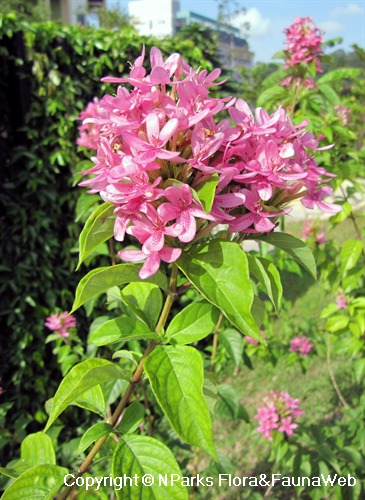
Back
Ruspolia hypocrateriformis (Vahl) Milne-Redh.
| Family Name: | Acanthaceae |
| Synonyms: | Justicia hypocrateriformis |
| Common Name: | Red Ruspolia, Ruddy Rose, Pricklybush |
Name
Classifications and Characteristics
| Plant Division | Angiosperms (Flowering Seed Plants) (Dicotyledon) |
|---|---|
| Plant Growth Form | Shrub |
| Lifespan (in Singapore) | Perennial |
| Mode of Nutrition | Autotrophic |
| Maximum Height | 1 m to 2 m |
Biogeography
| Native Distribution | Zimbabwe, South Africa |
|---|---|
| Native Habitat | Terrestrial (Grassland / Savannah/ Scrubland) |
| Preferred Climate Zone | Tropical |
Description and Ethnobotany
| Others - Plant Morphology | Growth Form: Evergreen, woody shrub. Habitat: Occurs in low-lying bushland at an altitude of 800 - 900 m. It is considered a weed in Central Africa. Stems: Stems are angled. Foliage: Opposite leaves are ovate with entire leaf margin. Leaf apex may be acute or have a drip tip. Flowers: Salverform flowers have 5 pink lobes that vary slightly in size (3 cm long, 2.5 cm wide). One of the 5 lobes has a distinct red patch near the base of the petal, while the other 4 lobes may or may not have similar, but smaller red markings. The tip of the petal may be rounded or slightly pointed. Flowers are arranged around a spike inflorescence. Fruits: Dry, explosively dehiscent fruits are known as capsules. They are elongated and flattened like a paddle with a slightly wavy margin near the sharply pointed apex. They open lengthwise to release a few disk-shaped, dark brown seeds Seeds are attached to hook-like structures inside the fruit which may cause seeds to fly further away from the plant during dehiscence. Landscaping: This species is grown as an ornamental shrub for its showy pink to red flowers. It is ideal for attracting butterflies as a nectar plant. This species is fairly rare in the horticultural trade, so it would provide interest to your garden as a specimen plant. Cultivation: This species is fast growing and hardy. Mature plants are tolerant of both drought and heat. They should be grown in fertile, well-drained soil. Plant this species in full sun or light shade, because shady conditions inhibit flowering and result in leggy plants. Feed plants with a fertilizer rich in phosphorous to promote flowering. Avoid using nitrogen rich fertilizers, because they encourage development of leaves rather than flowers. Try not to prune this species frequently, because flowers are produced from the new growth. Propagation: Propagate by seed or stem cuttings. Cuttings will root easily and produce flowers within a year. Etymology: The genus "Ruspolia" was named after Italian naturalist Eugenio Ruspoli (1866-1893). The species epithet "hypocrateriformis" is Latin for salverform and refers to the shape of the flowers. |
|---|
Landscaping Features
| Desirable Plant Features | Ornamental Flowers |
|---|---|
| Landscape Uses | Focal Plant |
| Thematic Landscaping | Butterfly Garden, Naturalistic Garden |
Fauna, Pollination and Dispersal
| Fauna Pollination Dispersal Associated Fauna | Butterfly-Attracting |
|---|---|
| Pollination Method(s) | Biotic (Fauna) (Insects (Butterfly, Moth)) |
| Seed or Spore Dispersal | Abiotic (Explosive Dehiscence) |
Plant Care and Propagation
| Light Preference | Semi-Shade, Full Sun |
|---|---|
| Water Preference | Moderate Water |
| Plant Growth Rate | Fast |
| Rootzone Tolerance | Drought Tolerant, Fertile Loamy Soils, Well-Drained Soils |
| Propagation Method | Seed, Stem Cutting |
Foliar
| Foliage Retention | Evergreen |
|---|---|
| Mature Foliage Colour(s) | Green |
| Mature Foliage Texture(s) | Smooth |
| Foliar Type | Simple / Unifoliate |
| Foliar Arrangement Along Stem | Opposite |
| Foliar Shape(s) | Non-Palm Foliage (Ovate) |
| Foliar Venation | Pinnate / Net |
| Foliar Margin | Entire |
| Foliar Apex - Tip | Acute, Acuminate |
| Foliar Base | Rounded / Obtuse |
| Typical Foliar Area | Mesophyll ( 45cm2 - 182.25 cm2 ) |
| Leaf Area Index (LAI) for Green Plot Ratio | 4.5 (Shrub & Groundcover - Dicot) |
Non - Foliar and Storage
| Bark Colour(s) | grey |
|---|---|
| Mature Bark Texture | Smooth |
| Stem Type & Modification | Woody |
| Root Type | Underground (Tap Root) |
Floral (Angiosperm)
| Flower & Plant Sexuality | Bisexual Flowers |
| Flower Colour(s) | Red |
|---|---|
| Flower Symmetry | Bilateral |
| Individual Flower Shape | Salverform |
| Flower Size - Remarks | 2.5 cm wide |
| Flowering Opening Time | Daytime |
| Flowering Habit | Polycarpic |
Fruit, Seed and Spore
| Mature Fruit Colour(s) | Brown |
|---|---|
| Fruit Classification | Simple Fruit |
| Fruit Type | Dehiscent Dry Fruit , Capsule |
Image Repository
Others
| Master ID | 1112 |
|---|---|
| Species ID | 2405 |
| Flora Disclaimer | The information in this website has been compiled from reliable sources, such as reference works on medicinal plants. It is not a substitute for medical advice or treatment and NParks does not purport to provide any medical advice. Readers should always consult his/her physician before using or consuming a plant for medicinal purposes. |

